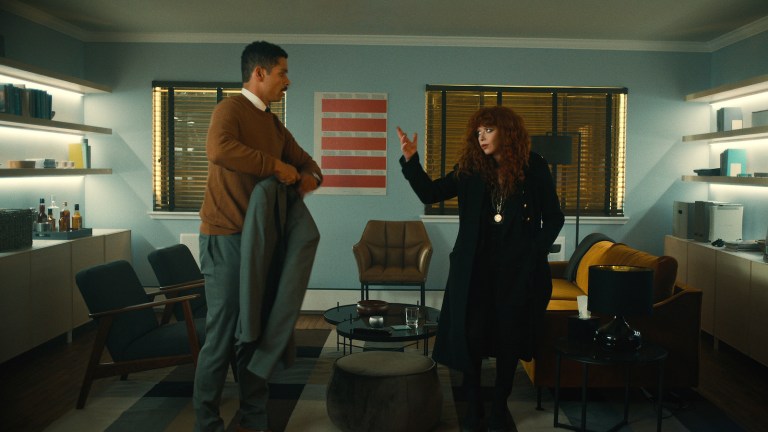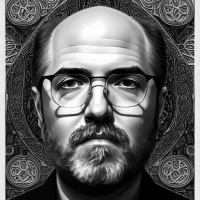Russian Doll Season 2 Ending Explained
Russian Doll is accustomed to dismantling reality in its season finales, but there are lessons to be learned when things are put right.

This article contains spoilers for Russian Doll season 2.
Let’s not kid ourselves; the “ending explained” part of this article’s headline is nothing if not ambitious when it comes to a show like Russian Doll, and this is particularly true of its second season. Implying that there’s an explanation to be gleaned goes against every lesson Nadia and Alan learn in the course of the seven episodes. If there’s any resolution at all in the finale, it’s that the time traveling pair have once again learned a little bit about why they are who they are and come that much closer to self-acceptance.
That being said, the descent into the genuinely surreal does warrant some exploration. There are plenty of paradoxes in Russian Doll season 2, but none break reality quite like Nadia removing her infant self from the 80s, presumably to prevent the traumatic upbringing the younger her will experience (has experienced). But why does this particular bit of meddling create such chaos even when none of her other attempts at change had any effect?
The answer lies with the acquisition of the krugerrands. Once Nadia realized that the family valuables she reclaimed from the Nazis led directly to the trade for the gold coins, she knew that her interference in the past actually caused the circumstances she remembered rather than changing anything. It’s a “closed loop,” she later tells Alan, also known as an ontological paradox, but because cause leads to effect and back to cause again, it’s a self-contained circle. Such causal loops don’t really interfere with reality around them; they just create confusing temporal relationships.
It’s a whole different matter when you remove your younger self from the past. This is akin to the grandfather paradox, in which the time traveler goes back and kills their own progenitor, undoing their own existence but also negating their ability to travel back in the first place. Cause leads to an effect that cancels the cause. Reality can’t accept Nadia taking her infant incarnation to the present, so everything goes haywire.
As an interesting digression, sharp-eyed viewers may spot in the New York streets of the finale’s broken reality a hawker announcing a balloon launch in Astor Place. This refers to a July 1911 publicity stunt outside Wanamaker’s department store, but the hydrogen balloon could not be steered to the companion store in Philadelphia as planned; instead it drifted north and landed unceremoniously in Nyack. This is perhaps a metaphor for the lack of control Nadia had in steering the events of her own life.
In any case, if Russian Doll season 1 was about self-acceptance and overcoming guilt, season 2 was about understanding how the past shapes who we are for better or worse. Nadia realizes that by not living in the present, she has missed being at Ruthie’s bedside in her final moments. Only when she sees the only mother she’s ever known stuck in a perpetual ascent up the stairs to her birthday party does she accept what Alan is telling her: she must take the baby back.
But it’s not that simple, and as usual, the transient sage Horse speaks the central truth as he leads Nadia and Alan to their awakening. “Everything falls down,” he says. “The closer you are to the center of the Earth, the closer you are to the truth.” Therefore when Alan and Nadia find themselves between two colliding trains, they are sent down, down, down to learn their final lesson in a water-logged tunnel that leads to the one fact that they must accept.
For Alan, there is a less satisfying resolution that may at first puzzle some Russian Doll viewers. He meets his grandmother, who confirms that she has no idea if Lenny made it out of East Berlin as a result of her efforts in the 60s. Alan had trouble conceiving of why someone would risk everything knowing the Berlin Wall would eventually fall, but of course Lenny was concerned only about his own present, just as Alan should be. Perhaps the better lesson for Alan is that he could love someone like Lenny, putting his failed relationship with Beatrice last season in a new light.
Nadia’s acceptance is more symbolic. She once again finds the bag of krugerrands floating along in the water, but she cannot retrieve them without dropping the baby Nadia. Instead, she must let the coins sink and press on, returning her infant self to Lenora while multiple versions of her family look on in mute approval. One could speculate that even without her meddling in the past, the family fortune would only have been lost sooner, and the resulting life for Nadia, from her mentally ill mother to the caring Ruthie, would have been exactly the same.
We are who we are because of the crushing defeats and soaring victories we experience throughout our lives. As Alan’s wise grandmother says, “We can’t spend our lives so scared of making the wrong move that we never live at all.” The two Russian Doll protagonists learn not to pursue what Nadia calls their “Coney Island,” the thing that would make everything better if only it had happened or didn’t happen — an “if only.”
So the “ending explained” for Russian Doll ends up being a restatement of the theme this insightful show has pursued since the beginning: that of self-acceptance. The universe has chosen Nadia and Alan to undergo a journey of awakening, and we as viewers are along for the ride. Just follow the rules of the train, and be a good commuter!

